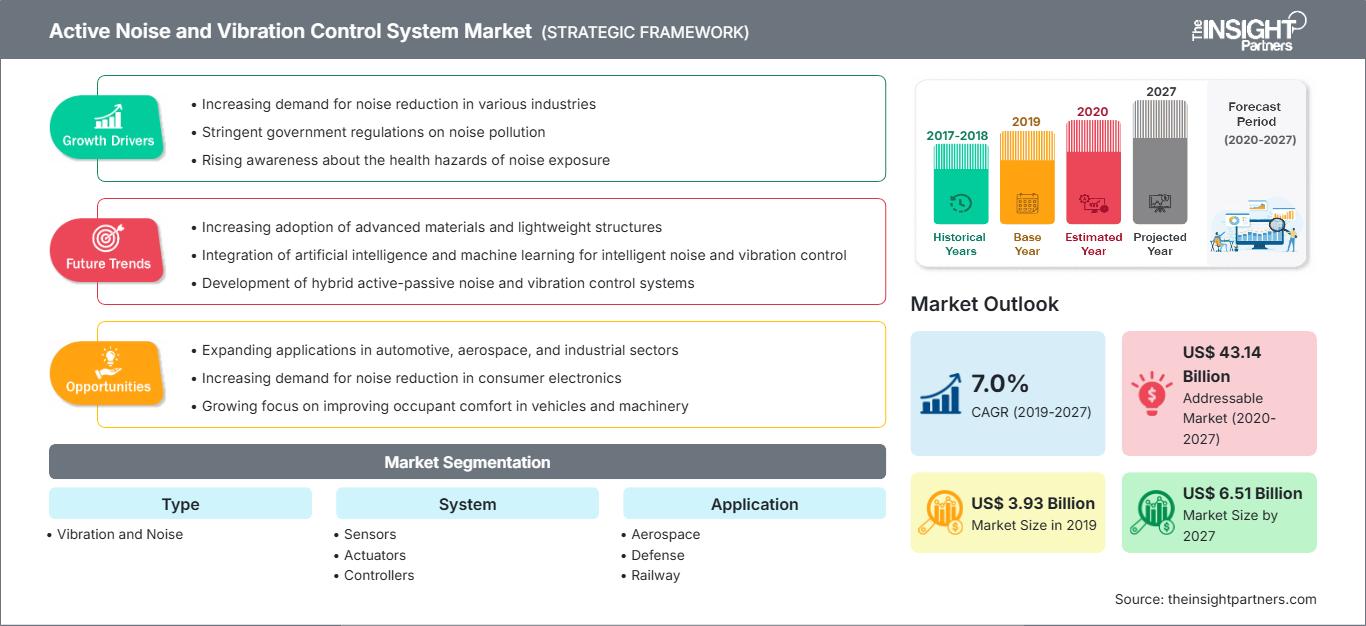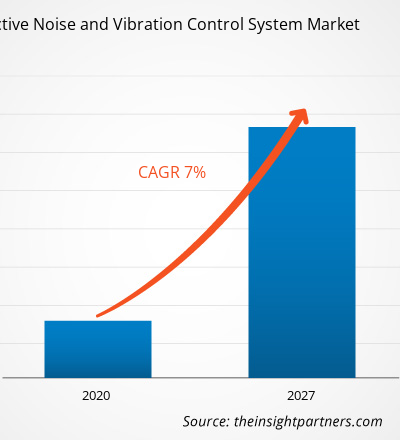Der globale Markt für aktive Lärm- und Vibrationskontrollsysteme hatte im Jahr 2019 einen Umsatz von 3.925,61 Millionen US-Dollar und soll bis 2027 voraussichtlich 6.505,28 Millionen US-Dollar erreichen; im Prognosezeitraum von 2020 bis 2027 wird ein CAGR-Wachstum von 7,0 % erwartet.
Der Markt für aktive Lärm- und Vibrationskontrollsysteme ist grob in fünf Hauptregionen segmentiert: Nordamerika, Europa, APAC, MEA und SAM. Die Luft- und Raumfahrt- sowie Verteidigungsindustrie in Nordamerika ist dank der Existenz einer großen Anzahl von Flugzeugherstellern und der kontinuierlichen Unterstützung durch das US-Verteidigungsministerium ausgereift. Die Nachfrage nach fortschrittlichen Technologien ist in der Region enorm, und alle oben genannten Endnutzer sind sich der neueren Technologien durchaus bewusst. Das US-Verteidigungsministerium investiert kontinuierlich Zeit und Geld in die Weiterentwicklung der bestehenden Flotte und die Entwicklung robuster gepanzerter Bodenfahrzeuge sowie Seeschiffe mit dem Ziel, eine einsatzbereite Truppe aufrechtzuerhalten. Die Präsenz einer großen Anzahl von Herstellern aktiver Lärm- und Vibrationskontrollsysteme in der Region unterstützt die ständig steigende Nachfrage, was wiederum den Markt für aktive Lärm- und Vibrationskontrollsysteme ankurbelt.
Passen Sie diesen Bericht Ihren Anforderungen an
Sie erhalten kostenlos Anpassungen an jedem Bericht, einschließlich Teilen dieses Berichts oder einer Analyse auf Länderebene, eines Excel-Datenpakets sowie tolle Angebote und Rabatte für Start-ups und Universitäten.
Markt für aktive Geräusch- und Vibrationskontrollsysteme: Strategische Einblicke

- Holen Sie sich die wichtigsten Markttrends aus diesem Bericht.Dieses KOSTENLOSE Beispiel umfasst Datenanalysen, die von Markttrends bis hin zu Schätzungen und Prognosen reichen.
Markteinblicke – Markt für aktive Lärm- und Vibrationskontrollsysteme: Zunehmende Nutzung aktiver Systeme im Schienenfahrzeugbau
Sie erhalten kostenlos Anpassungen an jedem Bericht, einschließlich Teilen dieses Berichts oder einer Analyse auf Länderebene, eines Excel-Datenpakets sowie tolle Angebote und Rabatte für Start-ups und Universitäten.
Markt für aktive Geräusch- und Vibrationskontrollsysteme: Strategische Einblicke

- Holen Sie sich die wichtigsten Markttrends aus diesem Bericht.Dieses KOSTENLOSE Beispiel umfasst Datenanalysen, die von Markttrends bis hin zu Schätzungen und Prognosen reichen.
Die Schienenfahrzeugindustrie wächst weltweit seit Jahren rasant. Zahlreiche technologische Fortschritte sorgen für mehr Sicherheit und Komfort beim Reisen. Schienenfahrzeuge (Drehgestelle und Lastenwagen) sind starken vertikalen Vibrationen und Lärm ausgesetzt, die im Betrieb verschiedene Risiken bergen. Um Vibrationen und Lärm zu unterdrücken, setzen viele Schienenfahrzeughersteller verstärkt auf Lärm- und Vibrationskontrollsysteme. Passive Lärm- und Vibrationskontrollsysteme sind bei Schienenfahrzeugherstellern weit verbreitet, da sie ihren Kunden sicherere und komfortablere Produkte anbieten können. Die meisten passiven Systeme sind jedoch hydraulische Systeme. In den letzten Jahren setzen Schienenfahrzeughersteller verstärkt auf elektronisch/elektrisch gesteuerte Systeme, was die zunehmende Beliebtheit aktiver Lärm- und Vibrationssysteme widerspiegelt. Ein aktives System mit Trägheitsmassenaktuatoren an den Drehgestellen kann niederfrequente Geräusche und Vibrationen in den Abteilen kontrollieren. Darüber hinaus handelt es sich bei den aktiven Systemen im Allgemeinen um elektromechanische Systeme, die sich bei den Herstellern von Bahnausrüstung zunehmender Präferenz erfreuen. Dieser Faktor dürfte die Nachfrage nach aktiven Systemen bei den Herstellern von Bahnausrüstung deutlich steigern und so den Markt für aktive Lärm- und Vibrationskontrollsysteme ankurbeln.
Einblicke in das Typensegment
Nach Typ dominierte das Vibrationssegment 2019 den globalen Markt für aktive Lärm- und Vibrationskontrollsysteme. Aktive Vibrationskontrollsysteme sind Isolationssysteme, die dynamisch auf externe Vibrationen reagieren. Diese Systeme werden verwendet, um Reibung zu reduzieren und Vibrationen in beweglichen oder statischen Maschinen zu kontrollieren.
Einblicke in das Systemsegment
Nach System dominierte das Aktuatorsegment 2019 den globalen Markt für aktive Lärm- und Vibrationskontrollsysteme. Aktuatoren werden in die aktiven Lärm- und Vibrationskontrollsysteme integriert, um verschiedene Kräfte innerhalb der Anlage zu kontrollieren und so den Gesamtbetrieb zu verbessern. Diese Aktuatoren nutzen unterschiedliche Technologien wie Piezoelektrizität, Elektrodynamik und hydraulische Elektrodynamik.
Einblicke in Branchensegmente
Nach Branchen betrachtet dominierte das Luft- und Raumfahrtsegment im Jahr 2019 den globalen Markt für aktive Lärm- und Vibrationskontrollsysteme. Die Luft- und Raumfahrtindustrie floriert seit Jahren exponentiell und weist eine große Anzahl an Produktionen und Lieferungen auf. Die Flugzeughersteller und Komponentenhersteller sehen sich einem erheblichen Druck seitens der Endverbraucher der kommerziellen Luftfahrt ausgesetzt, immer mehr Flugzeuge auszuliefern.
Die Marktteilnehmer konzentrieren sich auf Produktinnovationen und -entwicklungen, indem sie fortschrittliche Technologien und Funktionen in ihre Produkte integrieren, um mit der Konkurrenz mithalten zu können.
- 2019 gab Creo Dynamics die Übernahme der Mehrheitsbeteiligung durch Faurecia bekannt, um die Kompetenz des Unternehmens im Bereich aktive Geräuschkontrolle und Akustik im Automobilbereich mit Faurecia zu bündeln und einzigartige neue Lösungen für den Markt zu entwickeln.
- 2019 gab Terma die Unterzeichnung eines Vertrags mit UASF zur Lieferung von 3D-Audiosystemen für A-10-Flugzeuge bekannt.
- 2018 gab die Vicoda GmbH die Lieferung von Schwingungstilgern für Fußgängerbrücken in Gent bekannt, um durch Fußgänger verursachte Vibrationen zu kontrollieren und zu reduzieren und durch die Verhinderung von „Lock-in“ Komfortanforderungen zu erfüllen. Effekt.
Der globale Markt für aktive Lärm- und Vibrationskontrollsysteme wurde wie folgt segmentiert:
Markt für aktive Geräusch- und Vibrationskontrollsysteme
Die Analysten von The Insight Partners haben die regionalen Trends und Faktoren, die den Markt für aktive Geräusch- und Vibrationskontrollsysteme im Prognosezeitraum beeinflussen, ausführlich erläutert. In diesem Abschnitt werden auch die Marktsegmente und die geografische Lage aktiver Geräusch- und Vibrationskontrollsysteme in Nordamerika, Europa, im asiatisch-pazifischen Raum, im Nahen Osten und Afrika sowie in Süd- und Mittelamerika erörtert.Umfang des Marktberichts zu aktiven Geräusch- und Vibrationskontrollsystemen
| Berichtsattribut | Einzelheiten |
|---|---|
| Marktgröße in 2019 | US$ 3.93 Billion |
| Marktgröße nach 2027 | US$ 6.51 Billion |
| Globale CAGR (2019 - 2027) | 7.0% |
| Historische Daten | 2017-2018 |
| Prognosezeitraum | 2020-2027 |
| Abgedeckte Segmente |
By Typ
|
| Abgedeckte Regionen und Länder | Nordamerika
|
| Marktführer und wichtige Unternehmensprofile |
|
Dichte der Marktteilnehmer für aktive Lärm- und Vibrationskontrollsysteme: Verständnis ihrer Auswirkungen auf die Geschäftsdynamik
Der Markt für aktive Lärm- und Vibrationskontrollsysteme wächst rasant. Dies ist auf die steigende Nachfrage der Endverbraucher zurückzuführen, die auf Faktoren wie veränderte Verbraucherpräferenzen, technologische Fortschritte und ein stärkeres Bewusstsein für die Produktvorteile zurückzuführen ist. Mit der steigenden Nachfrage erweitern Unternehmen ihr Angebot, entwickeln Innovationen, um den Bedürfnissen der Verbraucher gerecht zu werden, und nutzen neue Trends, was das Marktwachstum weiter ankurbelt.
- Holen Sie sich die Markt für aktive Geräusch- und Vibrationskontrollsysteme Übersicht der wichtigsten Akteure
- Vibration
- Lärm
Markt für aktive Lärm- und Vibrationskontrollsysteme – nach System
- Sensoren
- Aktuatoren
- Controller
- Dämpfer
Markt für aktive Lärm- und Vibrationskontrollsysteme – nach System
- Luft- und Raumfahrt
- Starrflügler
- Drehflügler
- Verteidigung
- Bodenfahrzeuge
- Marineschiffe
- Eisenbahn
- Allgemeine Industrie
- Fertigung
- Energie & Strom
Markt für aktive Lärm- und Vibrationskontrollsysteme – Nach System
- Sensoren
- Aktoren
- Steuerungen
- Dämpfer
Markt für aktive Lärm- und Vibrationskontrollsysteme – nach Region
- Nordamerika
- USA
- Kanada
- Mexiko
- Europa
- Frankreich
- Deutschland
- Italien
- Großbritannien
- Russland
- Übriges Europa
- Asien-Pazifik (APAC)
- China
- Indien
- Südkorea
- Japan
- Australien
- Übriges APAC
- Naher Osten und Afrika (MEA)
- Südafrika
- Saudi-Arabien Arabien
- VAE
- Rest von MEA
- Südamerika (SAM)
- Brasilien
- Rest von SAM
Markt für aktive Lärm- und Vibrationskontrollsysteme – Unternehmensprofile
- FABREEKA
- Honeywell International Inc.
- HUTCHINSON
- Terma A/S
- Moog Inc.
- Parker Hannifin
- Faurecia Creo AB
- Supashock
- Trelleborg AB
- VICODA GmbH
- Historische Analyse (2 Jahre), Basisjahr, Prognose (7 Jahre) mit CAGR
- PEST- und SWOT-Analyse
- Marktgröße Wert/Volumen – Global, Regional, Land
- Branchen- und Wettbewerbslandschaft
- Excel-Datensatz
Aktuelle Berichte
Erfahrungsberichte
Grund zum Kauf
- Fundierte Entscheidungsfindung
- Marktdynamik verstehen
- Wettbewerbsanalyse
- Kundeneinblicke
- Marktprognosen
- Risikominimierung
- Strategische Planung
- Investitionsbegründung
- Identifizierung neuer Märkte
- Verbesserung von Marketingstrategien
- Steigerung der Betriebseffizienz
- Anpassung an regulatorische Trends




















 Kostenlose Probe anfordern für - Markt für aktive Geräusch- und Vibrationskontrollsysteme
Kostenlose Probe anfordern für - Markt für aktive Geräusch- und Vibrationskontrollsysteme